What else have the members of the Department of Astronomy & Planetary Science been doing?
Our faculty, staff, and students are making a difference on campus and around the world. Read about some of our achievements, activities, and successes.
Thanks to David Trilling for keeping track of all these accomplishments!
December 2018
Ryan Behunin is the co-author of a paper: Accordion Closed
“Optomechanical cooling in a continuous system,” which will publish in Physical Review on Friday. The paper, based on the theory Behunin contributed to, features a new cooling technique using laser light.
Congratulations to our SPS Chapter for being recognized as a 2017-2018 Distinguished Chapter by the SPS National Office! Accordion Closed
Please congratulate the students, and Buzz Delinger for leading them, when you see them on this honor!
David Trilling gave an invited talk Accordion Closed
at the TMT Science Forum in Pasadena.
President Cheng announced that NAU had risen to the top 100 ranking for external funding for non-medical school universities, Accordion Closed
and rank #201 overall. In that letter (Dec. 11) she explicitly called out both astronomy and planetary sciences as areas of research that have contributed to this success.
David Trilling is PI of a newly accepted survey program at NOAO (National Optical Astronomy Observatory Accordion Closed
— the national observatory) entitled “The Deep DECam Outer Solar System Survey.” (DECam is the name of the large-format camera that we will use.) There are 16 co-investigators, including NAU faculty member Chad Trujillo, postdoc Andrew McNeill, and PhD student Will Oldroyd. Former NAU postdocs Michael Mommert and Cesar Fuentes are also CoIs. We have been awarded 46.5 nights of telescope time (that’s a lot!) over the next three years. We will use this time to study the properties of small bodies in the outer Solar System to constrain the formation and evolution of our planetary system.
Chad Trujillo is in the news again, for another far out discovery: Accordion Closed
The new object was announced on Monday, December 17, 2018, by the International Astronomical Union’s Minor Planet Center and has been given the provisional designation 2018 VG18. The discovery was made by Carnegie’s Scott S. Sheppard, the University of Hawaii’s David Tholen, and Northern Arizona University’s Chad Trujillo.
2018 VG18, nicknamed “Farout” by the discovery team for its extremely distant location, is at about 120 astronomical units (AU), where 1 AU is defined as the distance between the Earth and the Sun. The second-most-distant observed Solar System object is Eris, at about 96 AU. Pluto is currently at about 34 AU, making 2018 VG18 more than three-and-a-half times more distant than the Solar System’s most-famous dwarf planet.
Congratulations Graduates!!! Accordion Closed
We had eight undergrads and two masters students listed in the commencement program, and I think a few more graduates besides those. Congratulations to all the students who graduated, and to all faculty and staff who helped them reach this milestone.
November 2018
Ty Robinson’s NASA Exobiology proposal was selected. Accordion Closed
The proposed work is aimed at understanding the feasibility of remotely detecting chemical disequilibrium (indicated by large available Gibbs free energy in the atmosphere/ocean system) for Earth-twin exoplanets at different stages in Earth’s 4.5 Gyr evolution. Our efforts will incorporate collaborations with UC Riverside, Georgia Tech, NASA Goddard, NASA GISS, Columbia, University of Washington, and Arizona State. The award will include funds for both my summer efforts as well as 2.67 years of
an NAU graduate student. total: $470k
Undergrad Megan Gialluca (a physics/astronomy sophomore) has been selected to be a Goldwater Scholarship nominee from NAU. Accordion Closed
Megan is the first sophomore to receive this nomination in (at least) the last seven years here at NAU. The research Megan is emphasizing in her application is focused on modeling and characterizing rocky exoplanets around cool stars.
Megan Gialluca also participated this past week in an asteroid occultation observation in southern Arizona. Accordion Closed
She wrote: “So when we arrived in Tuscon on Monday we met up with our telescope partners, as I had mentioned mine was a man named Ted Blank and he was the head of the New Hampshire Astronomical Society when I had completed my first research paper! So that was pretty cool. We then loaded the car with crates containing the telescope mount parts, the telescope itself, and the data systems (computer, camera, wires, etc). Then we drove out to the practice site in Tuscon and set up the mount, scope, and system and did a practice run (so we aligned the scope, set the PAE, found the star field, and took about 100 frames during the time the occultation would be happening). Then on Tuesday we drove out to our assigned band which was originally predicted to be the first band on the North edge that would get a negative occultation. After setting everything up when the actual occultation time came around (about 8:08 pm AZ time) we took 1715 frames (about 10 min from 8:03 to 8:13) turns out we had a positive Occultation! So the shadow had shifted a little northwards. This viewing was for the upcoming Lucy mission scheduled to be launched in 2021 and the occultation was caused by trojan asteroids. Lucy is going to visit 6 trojan asteroids to hopefully tell us about the formation of the solar system.”

David Trilling is lead author of a new paper about `Oumuamua: Accordion Closed
“Spitzer Observations of Interstellar Object 1I/’Oumuamua.” Andrew McNeill, Alissa Roegge, and Nathan Smith are co-authors on this paper.
There was very nice press coverage of this article which received considerable press coverage, of which the following is just a small sample!
-
- NAU News: “NASA telescope’s ‘non-detection’ of first interstellar object in solar system leads NAU team to conclusions about mystery object’s size, reflectivity” There’s a link at the bottom to Colin Chandler’s 3D print-able model of this mysterious object!
- JPL: “NASA Learns More About Interstellar Visitor ‘Oumuamua“
- In China!: “NASA reveals more information on first interstellar object”
Ryan Behunin has a new grant that was just funded: Accordion Closed
This grant is a 3.75M award divided between UCSB, Yale, Stanford, NIST, Microsoft and NAU to create ultra-stable lasers to drastically reduce energy consumed through information processing used to power the internet (currently 10% of the world energy budget).
David Trilling was a convener for the recent NOAO ELT KSP workshop in Tucson: Accordion Closed
What does that mean? NOAO is the National Optical Astronomy Observatory — the national observatory headquarters. ELT is Extremely Large Telescopes — a catch-all phrase for telescopes in the coming decade that will be ~30 meters in diameter. And KSP is Key Science Program — identifying some key scientific investigations that could be carried out with these coming giant telescopes.
Mark Salvatore and PhD student Schuyler Borges are on their way to Antarctica! Accordion Closed
(First stopping off to visit their respective families.) They’ll be in New Zealand in a week or so, and a few days later land in McMurdo Base in Antarctica. Their field seasons will be 2+ months, and they are hoping to send us pictures/blog posts/etc. AND: PhD student Helen Eifert leaves for a separate field campaign in Antarctica in a few weeks. We can’t wait to hear from all of them about their adventures.
You can follow their adventure on Mark’s Blog.
October 2018
Chad Trujillo is a co-author on a new paper that has attracted press attention: Accordion Closed
“A New High Perihelion Inner Oort Cloud Object: 2015 TG387” which has received some press attention.
Edwards served on a panel for the Arizona Aerospace and Defense STEM/Workforce summit Accordion Closed
alongside the deans of engineering for ASU and UofA and the Chancellor of Embry Riddle.
Undergrads Hannah Zigo and Heshani Pieris presented results at NASA”s Mars Odyssey THEMIS science team meeting Accordion Closed
at ASU. Christopher Edwards also presented results related to Phobos.
Christopher Edwards had a paper published in Earth and Space Science Accordion Closed
related to the field-analog testing of a variety of technologies: “Incorporation of Portable Infrared Spectral Imaging Into Planetary Geological Field Work: Analog Studies at Kīlauea Volcano, Hawaii, and Potrillo Volcanic Field, New Mexico”
Ty Robinson’s research group has been invited to join NASA’s Nexus for Exoplanet System Science (NExSS). Accordion Closed
The NExSS group works to connect different research programs in exoplanets across the country, and also organizes workshops and conferences for both NExSS teams and the larger exoplanet community. Additionally, NExSS membership comes with access to funds to support team travel to NExSS workshops and events.
At the president’s forum, Ed Anderson and Mary Lara, and Cristina Thomas, were highlighted by name. Accordion Closed
Also, Christopher Edwards and Nathan Smith were shown in one of the slides about research productivity.
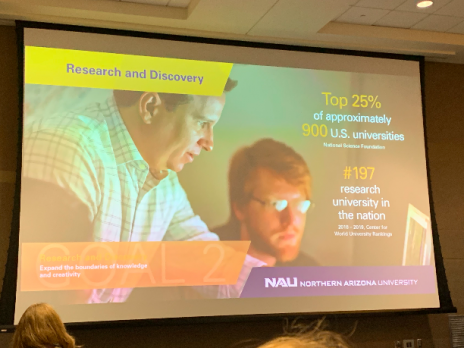
NAU hosted the NAPSA [Northern Arizona Planetary Science Alliance] poster session, Accordion Closed
organized by Nadine Barlow, Kathleen Stigmon, and others. President Cheng attended. We had at least nine grad students and at least seven undergraduates who presented posters.
Division of Planetary Sciences meeting. Accordion Closed
Faculty David Trilling, Cristina Thomas, Chad Trujillo, and Steve Tegler attended the American Astronomical Society/Division of Planetary Sciences meeting last week. Graduate students Samuel Navarro, Robyn Meier, and Annika Gustafsson; postdocs Andrew McNeill and Maggie McAdam; and undergraduate student Mitch Magnuson also attended. Together, NAU people authored/co-authored at least 25 abstracts. [My apologies if I left someone off this list!]
Physics and Astronomy submitted 49 full proposals Accordion Closed
from January 1, 2018 to October 19, 2018. Of these, 9 were for applied research ($5,152,819), 36 for basic research ($14,696,390) and 3 classified as other purposes ($276,868). The total dollar amount of the 49 proposals submitted through October 19, 2018 is $20,126,077.
PhD students Catherine Clark and Lori Glaspie submitted their NSF Graduate Research Fellowship proposals. Accordion Closed
Good luck to them! Kudos to Ty Robinson for his excellent mentoring of these students through the proposal process.
Navajo Bridge Star Party Accordion Closed
Students Janus Kozdon, Brennah Brown, Ryan Jundt and Emma Garret, along with staff members Kathleen Stigmon, Ed Anderson and Mary Lara attended the Navajo Bridge Star Party Oct. 12-13. The trip, which was sponsored by the NAU/NASA Space Grant, allowed the students to spend the weekend doing outreach with the public, bringing their own telescopes to stargaze both Friday and Saturday night. This is the second year a group from the department has participated in the party.
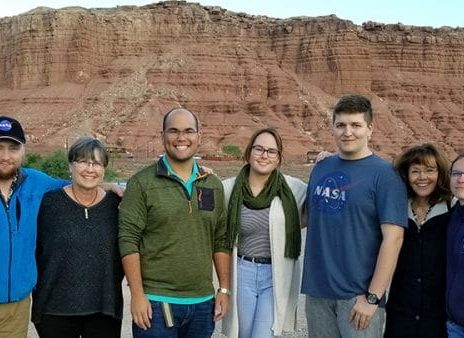
Planetary Analogs field trip to SP Crater and Colton Crater Accordion Closed
On October 27 a dozen students, postdocs, and faculty participated in the first official Planetary Analogs field trip to SP Crater and Colton Crater; the trip was led by Crhistopher Edwards and postdoc Jean-Francois Smekens.
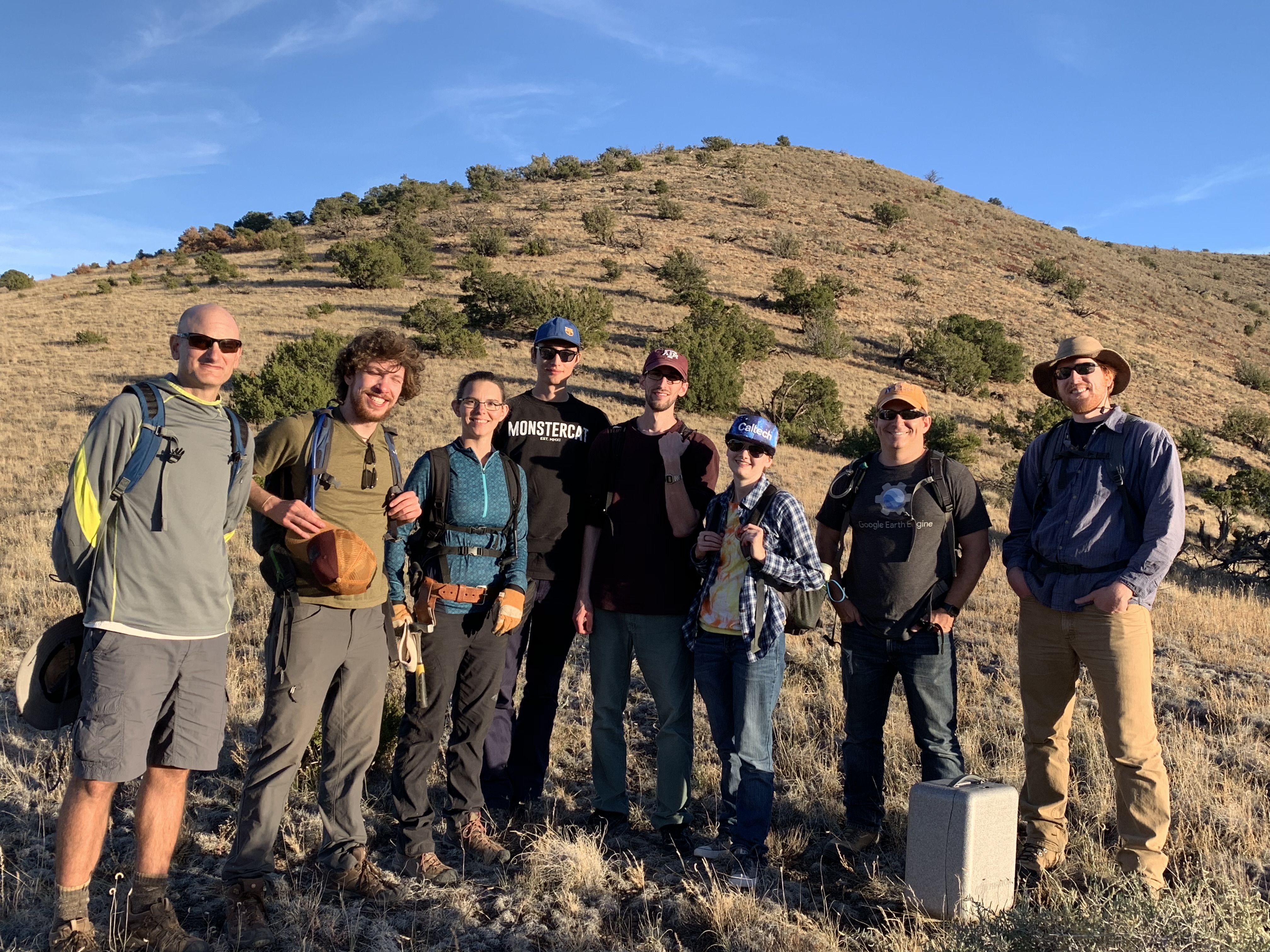
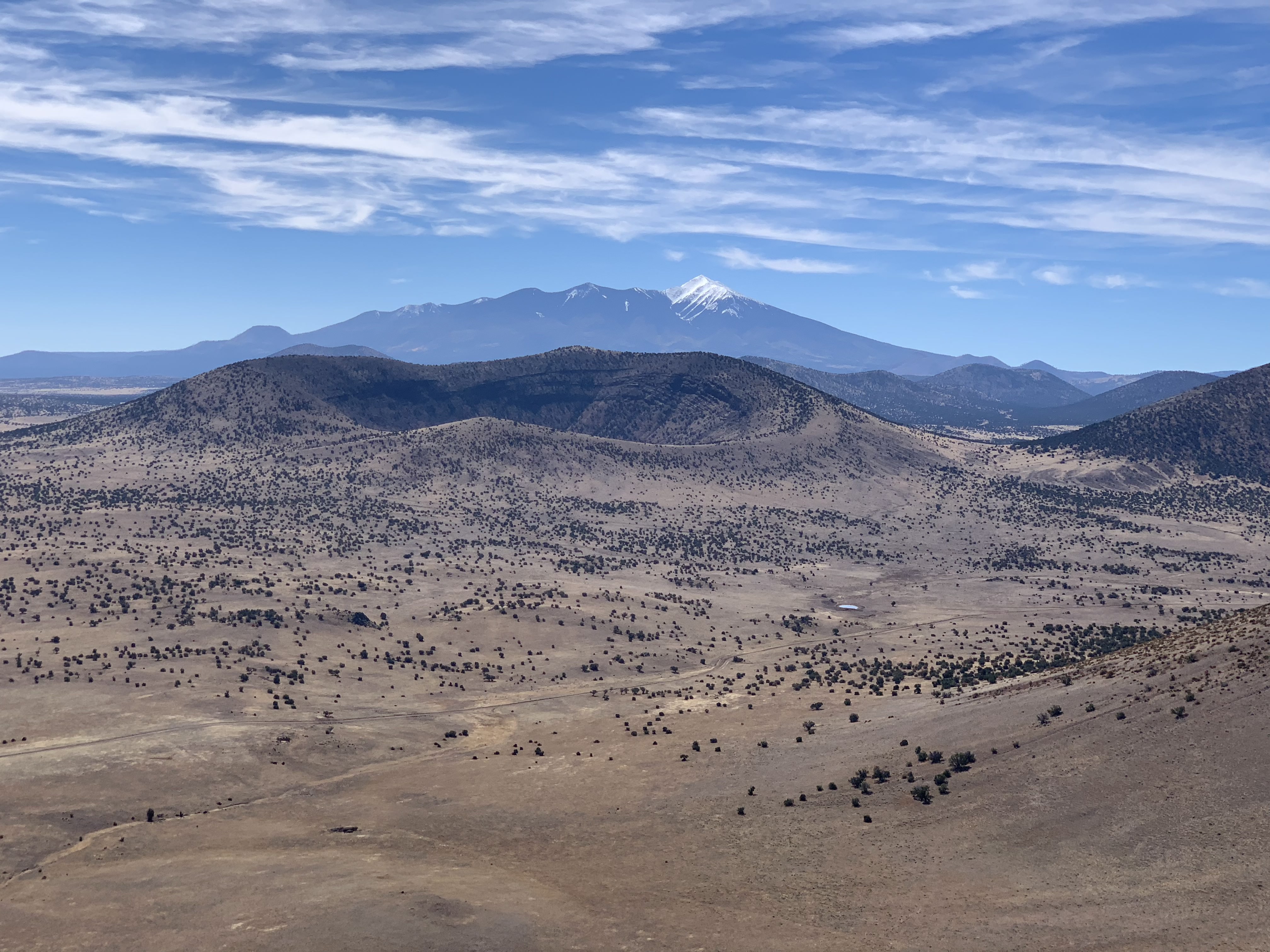
Postdoc Andrew McNeill is first author of a recently accepted paper: Accordion Closed
“Extreme asteroids in the Pan-STARRS 1 Survey” David Trilling is a co-author.
Undergraduate Adrian Luna received a travel scholarship and presented his poster Accordion Closed
‘Quantum Engineering following Nature’s lead: Using genetic algorithms to develop nitride optoelectronic devices’ (Adrian Luna, Robert Voinescu, John Castañeda, and Inès Montaño) at the SACNAS conference in San Antonio.
Undergraduate Rachel Sobecki presented her poster, Accordion Closed
“Nitride Hyperbolic Metamaterials” (Rachel Sobecki and Inès Montaño) at the NAPSA symposium and will present the same at the SPS Zone Meeting that NAU is hosting.
Research associate Matthew Daunt presented his poster, Accordion Closed
“The Influence of Many-Body Effects on Light-Matter Interactions in Semiconductor Nanostructures” (Matthew Daunt and Inès Montaño) at the NAPSA symposium.
Visiting PhD student Samuel Navarro Accordion Closed
had a busy October and presented four talks/posters in Mexico and the US:
-
-
-
- 10/01 Colloquium. NEOs: “Rapid-response Spectrophotometric characterization of Near Earth Objects with RATIR” at the Institute of Astronomy, UNAM, campus Ciudad Universitaria, México City, México.
- 10/11 Poster presentation. “Near Earth Objects characterization with the 1.5m telescope from the National astronomic observatory (Caracterización de objetos cercanos a la Tierra (NEOs) con el telescopio de 1.5m del Observatorio Astronómico Nacional)” at the National astronomy meeting (Congreso Nacional de Astronomía), Puebla, Puebla, México
- 10/17 Colloquium. NEOs: “Rapid-response Spectrophotometric characterization of Near Earth Objects with RATIR” at the Institute of Astronomy, UNAM, campus Ensenada, Ensenada, B.C., México
- 10/26 Talk. “First results from the rapid-response spectrophotometric characterization of Near-Earth Objects using RATIR.” at the DPS meeting, Knoxville, Tennessee, USA.
-
-
September 2018
David Trilling has been named a “co-convener” for the national Extremely Large Telescope Key Science Programs. Accordion Closed
This is a group that will help define projects that could be carried out with the next generation of very large (~30 meter) telescopes. David’s co-convener for Solar System science topics is Tommy Greathouse — presently at SWRI in Texas and a 1997 alumnus of our department!
Christopher Edwards’ NASA Solar System Workings proposal was funded: Accordion Closed
“Testing the Limits of Spectral Mixture Modeling in the Thermal Infrared: Insights from Radiative Transfer Modeling and Laboratory Spectral Analysis” ($469K with grad student for 3 years).
Mark Salvatore was a panelist for a virtual workshop Accordion Closed
hosted by the “Next Generation Lunar Scientists and Engineers group” on preparing for interviews and job talks.
NAU/NASA Space Grant attended the Navajo Nation Fair’s Youth Day Accordion Closed
, and they had added a STEM education component to it. Knowing that between 1,000-4,000 students might be there, Sam Navarro, Sam Sarkar, and Richard Gaughan volunteered to go and help Kathleen Stigmon. In addition, Allison Vance (a friend of the department), who has planetarium educator background, volunteered to go along as well.” A few pictures from their event are in our Scrapbook. Thank you, Kathleen, Sam, Sam, Richard, and Allison!
Lowell and NAU hosted the fourth annual Flagstaff Astronomy Symposium on September 21. Accordion Closed
NAU speakers included faculty Nadine Barlow, Kathy Eastwood, Cristina Thomas, and Chad Trujillo; postdocs Jennifer Buz and Kathryn Powell; grad students Colin Chandler, Erin Aadland, Robyn Meier, Catherine Clark, and Shy Dustrud; and researchers Anna Engle and Nathan Smith. All the talks were terrific! Phil Massey (Lowell) and David Trilling (NAU) hosted and co-organized the symposium.
Cristina Thomas is the coordinator of ground-based observing for NASA’s DART mission. Accordion Closed
She submitted 1 proposal to the IRTF and was Co-I on 7 proposals to observe Didymos around the world (so far). The Didymos proposals are for some of the largest ground-based facilities in the world: GTC, VLT, Gemini N & S, Keck, LBT and the MMT. There are only a couple left to submit after today, including the DCT.
Dave Koerner have a talk on Indigenous Astronomy at the Flagstaff Star Party Accordion Closed
in Buffalo Park.
A star party for the Friends of Camp Colton fundraiser Accordion Closed
was hosted by NAU staff Ed Anderson and Mary Lara and students Kathryn Turrentine, Kyle Ghaby, Kirstin Ligon, and Ryan Jundt. Camp Colton is an outdoor education facility run for the Flagstaff school district and they are keen to build more astronomy into their experience for the visiting students. Thank you all for representing our department, NAU, and astronomy so well!
PhD student Lori Glaspie participated in LPI’s Meteor Crater Field Experience. Accordion Closed
“I will join about a dozen students from all over the world in the rare opportunity to conduct research with Meteor Crater Staff Geologist and LPI Researcher Dr. David Kring. I’ll spend nine days within Barringer Crater, mapping various features of the crater and conducting research in support of impact cratering studies.”
August 2018
Christopher Edwards paper in Nature Astronomy was published and resulted in lots of press coverage: Accordion Closed
“Inventory of CO2 available for Terraforming Mars.” This article and NAU were mentioned in over 120 nationally and internationally recognized news articles. Such as
-
-
-
- AIRTALK — a NPR/KPCC radio show: “A mission to Mars may drive us crazy – but if we can’t terraform it then does it even matter?”
- A 5 minute news piece for KJZZ In Phoenix: “Researcher: Terraforming Mars Not In The Cards Right Now”
- The New York Times: Mars Is Frigid, Rusty and Haunted. We Can’t Stop Looking at It.
- Wired Magazine: Sorry, Nerds: Terraforming Might Not Work on Mars
- Quartz Magazine: NASA says nobody—not even Elon Musk—can terraform Mars
- VICE: Sorry Elon: NASA Says Mars Can’t Be Terraformed With Existing Technology
- NAU News: Think twice before moving to Mars—NAU planetary scientist refutes terraforming in NASA study
- NASA Press Release: Mars Terraforming Not Possible Using Present-Day Technology
-
-
Christopher Edwards was a part of 5 abstracts Accordion Closed
that were submitted to the American Geophysical Union Meeting, including one from Postdoc J.-F. Smekens and Graduate Student N. Smith
Edwards presented the EMIRS instrument at the international COSPAR conference Accordion Closed
and was a co-author one additional abstract related to the Emirates Mars Mission.
John Gibbs and undergrads, Andrew Andrew Leeth Holterhoff and Mingyang Li published Accordion Closed
Nadine Barlow and Michael Zeilnhofer participated in the 9th Planetary Crater Consortium meeting Accordion Closed
at the Southwest Research Institute in Boulder, CO, Aug. 8-10. Michael gave a talk on “Preliminary Investigations of Polygonal Craters on Ceres”. Nadine gave two talks: “Type 1 Ejecta Craters on Mars: Not Restricted to just the Double Layer Ejecta Morphology”, and “Constraints on the Timing of Tectonic Activity on Mercury’s Large-Scale Lobate-Scarp Thrust Faults”.
Chad Trujillo is co-author on a newly published paper: Accordion Closed
“New Jupiter Satellites and Moon-Moon Collisions” Press releases about this topic can be found on the APS news page.
Christopher Edwards has a paper in press on the composition of the martian moon Phobos Accordion Closed
(which is redacted until publication time).
July 2018
The Arizona Board of Regents funded three “Regents’ Innovation Fund” projects for FY19. Accordion Closed
These are three-campus research programs, typically for seed funding that will culminate in a larger, external funding proposal. One of these (“Seed Funding for an Innovative Three-University Near Earth Object (NEO) Space Mission”) is led by David Trilling. A second project, led by UA, has both Ryan Behunin and Ines Montano as CoIs.
Cristina Thomas is the lead Accordion Closed
of all ground-based (telescope) observing [both US and Europe] of asteroid Didymos for NASA’s DART mission.
Stephen Tegler, David Trilling, and others had a proposal approved Accordion Closed
and new observations obtained of Neptune’s moon Triton with the Gemini South telescope in May. Stay tuned for some cool stuff to come …
Colin Chandler’s paper Accordion Closed
(also with Michael Mommert, Chad Trujillo, and 2017 REU intern Anthony Curtis) is in press: “SAFARI: Searching Asteroids For Activity Revealing Indicators”
David Trilling spoke at the Seattle Astronomy on Tap. Accordion Closed
There were 250 people there!
David Trilling was awarded telescope time in December and January on NASA’s Infrared Telescope Facility Accordion Closed
(in Hawaii) to use MIRSI, amid-infrared camera that they have spent the last (many) years retrofitting.
Cristina Thomas also was awarded IRTF time for the fall semester Accordion Closed
She is the PI on one project; CoI on several more.
Lisa Chien is a Co-PI on an HST proposal granted time for cycle 25 Accordion Closed
titled “Star Cluster Formation and Evolution in Luminous Galaxy Mergers: A Joint JWST-HST Investigation”.
David Trilling was funded by the Air Force Research Lab Accordion Closed
to carry out a project entitled “Near infrared speckle imaging for research on stars, near Earth asteroids, and space situational awareness”
Mark Salvatore’s Antarctic grant was funded Accordion Closed
resulting in field work with incoming PhD student Schuyler Borges.
Mark Salvatore gets another funded award Accordion Closed
for Antarctic field work for incoming PhD student Helen Eifert.
Mark Loeffler’s NSF proposal selected for funding. Accordion Closed
“The Role of Temperature-Driven Chemical Reactions in the Evolution of Solar System Ices” was selected for
funding. It is a 3-yr award and will involve one PhD student.
The Department of Physics and Astronomy had a table at the Lunar Legacy Kickoff event at the Orpheum Theater on July 20. Accordion Closed
Faculty members Nadine Barlow, Ty Robinson, and Mark Salvatore and graduate students Lori Glaspie and Michael Zeilnhofer spent a couple of hours talking to the public about research in the Department and the visit of the astronauts to the campus telescope during their training in Flagstaff. Our impact cratering activity was a big hit with all ages.
June 2018
David Trilling is a member of a “study team” selected by the International Space Science Institute (in Switzerland): Accordion Closed
“First Contact: Making Sense of 1I/‘Oumuamua and Its Implications.” The goal of this team is “to consolidate the existing studies and explore avenues for future investigations” of interstellar objects like `Oumuamua, the interstellar asteroid that was discovered last October.
David Trilling is a co-author on a presentation Accordion Closed
given last month at the “SKA-Driven Big Data Challenge in Africa: Science, Innovation and Opportunity” Conference in Madagascar. No, he didn’t attend the conference in person.
Ryan Behunin and MS student Megan Chamberlain presented Accordion Closed
at the “Fluctuation-Induced Phenomena in Complex Systems” conference in Bad Honnef, Germany.
Christopher had three minutes in the spotlight Accordion Closed
when he talked at the recent ABOR meeting about all the great things that are happening in our department. Thanks for doing this!
Congratulations to Nathan Smith on successfully defending this masters thesis Accordion Closed
“Mapping the Thermal Inertia of Phobos using Thermal Infrared Spectra and Thermophysical Modeling”
Congratulations to PhD student Catherine Clark, Accordion Closed
who was awarded four nights on WIYN (telescope on Kitt Peak) in 2018B for her project “NESSI Survey of Potential Low-Mass Exoplanet Hosts.”
David Trilling and Cristina Thomas Accordion Closed
are CoIs on an approved NOAO 2018B telescope proposal entitled “The Mission Accessible Near-Earth Object Survey (MANOS),” which was allocated 40 hours of Gemini time.
Christopher Edwards’ EMIRS Phase D approved Accordion Closed
— totaling 1.1M over 2 years. This will support a 1/2 time coordinator, postdoc, 3 years of graduate students, and a data analyst.
Christopher Edwards had a paper published in Geosphere Accordion Closed
related to mapping the Himalayan mountains using satellite remote sensing data: “Structural relationship between the Karakoram and Longmu Co fault systems, southwestern Tibetan Plateau, revealed by ASTER remote sensing”
May 2018
Congratulations graduates! Accordion Closed
We had ~25 undergraduate majors and 4 masters students who graduated. Congratulations to all of them and to all of us!
Kyle Lindstrom took 1st Place in the Research Category among the 2018 CEFNS UGRADS Prize Winners. Accordion Closed
Kyle presented his Space Grant project (mentored by Dr. Lisa Prato at Lowell) on “Planet Formation around Binary and Multiple Star Systems” during Friday’s Undergraduate Symposium. He was recognized by the Dean during the CEFNS Pre-Commencement Reception on May 11.
Randy Dillingham and Tim Porter (former professor and Chair of our department) published a paper Accordion Closed
titled “In-Situ Measurement of Forest Soil Gases using Quadrupole Mass Spectrometry” in the International Journal of Earth & Environmental Sciences. This research used a battery powered, portable quadrupole mass spectrometer that was designed and constructed here at NAU with funding from a TRIF grant.
Nadine Barlow presented Accordion Closed
a talk on “Comparing Central Pit Craters across the Solar System: Characteristics and Implications for Formation Models” during the Geological Society of America Rocky Mountain/Cordilleran Joint Sectional meeting in Flagstaff on May 16. She also co-chaired the Recent Advances in Planetary Geoscience session.
Nadine Barlow, Christopher Edwards, Mark Salvatore, and Jean-Francois Smekens led “The Holey Tour: Planetary Analog Sites of Northern Arizona” field trip Accordion Closed
for 19 participants of the Geological Society of America Rocky Mountain/Cordilleran Joint Sectional meeting on May 18. The trip included explorations of Meteor Crater, Cinder Lake Crater Field, and SP and Colton volcanoes.
Nadine Barlow is a co-author on Accordion Closed
“Nuclear Nonsolution” (Aerospace America, v. 56, p. 44-47).
Nadine Barlow is a co-author on Accordion Closed
an abstract submitted to the European Planetary Science Congress, to be held September 16-21 in Berlin, Germany: “Warming Early Mars by Impact Degassing of Reduced Greenhouse Gases“.
Christopher Edwards’ EMIRS project has advanced to Phase D. Accordion Closed
This is a big deal (lots of money, and an official approval to move to the next step).
Magellan telescope time Accordion Closed
was awarded to incoming PhD student Erin Aadland and Phil Massey and, separately, Chad Trujillo, for the 2018B semester.
Former masters student Cassandra Lejoly was awarded a NASA Earth and Space Science (graduate) Fellowship Accordion Closed
She’s working on her PhD at UA.
Incoming PhD student James Windsor Accordion Closed
won the outstanding senior award from his college at U Toledo (the College of Natural Science and Mathematics).
April 2018
2nd year PhD student Colin Chandler was awarded an NSF graduate research fellowship, Accordion Closed
and there’s a great article about him in NAU news.
Nadine Barlow gave an invited presentation Accordion Closed
on “What We Know About Mars from its Impact Craters” at the Planetary Science Palooza on March 18, 2018, in The Woodlands, TX.
Alumnus, Sierra Ferguson, has passed her qualifying exam for the PhD program Accordion Closed
in the School of Earth and Space Exploration at ASU. She is working with Alyssa Rhoden (who gave a colloquium here a few weeks ago) on crater studies of icy satellites, particularly those in the Saturnian system. Another one of our undergraduate alums who is doing great!
Alumnus, Margaret Landis Accordion Closed
is a graduate student in the Lunar and Planetary Lab at Univ. AZ and expects to do her final dissertation defense this spring.
Christopher Edwards’ NASA PSTAR grant was selected Accordion Closed
Entitled “Linking Thermophysical Properties of Mars to Earth: Analog Investigations of Past and Present Habitable Environments”, the grant is for ~$1.2M and will support 2 NAU graduate students for 3 years. Only 6 of 47 (12.7%) proposals were selected.
Megan Gialluca and Anna Ross — were awarded HURA grants Accordion Closed
to conduct exoplanet-themed research next year under the supervision of Ty Robinson.
Olivia Thomas and Etude O’Neel-Judy, were congratulated by President Cheng Accordion Closed
during an award ceremony a couple of weeks ago. Olivia is the CEFNS Outstanding Senior, and Etude won a Gold Axe award. And at the ceremony Etude found out that he was also awarded the President’s Prize.
David Trilling has a new paper Accordion Closed
in press at the Astronomical Journal, “On the detectability of Planet X with LSST”
David Trilling and Michael Mommert are CoIs on an approved IRAM proposal Accordion Closed
to observe comet (formerly asteroid) Don Quixote in June. IRAM is a 30-meter radio telescope in Spain, and this is Trilling’s first ever research-grade radio astronomy project — pretty fun. No, they won’t go there in person to do the observing.
March 2018
Christopher Edwards organized and hosted the Google Earth Engine tutorial, Accordion Closed
March 1, led by Google’s Noel Gorelick. We hear that Flagstaff had one of the largest turnouts for this tutorial session of any place on Noel’s worldwide tour.
The first-ever “Planetary Analogs Field Trip” Accordion Closed
occurred on march 3-4, when three faculty and four grad students went to granite wash, in western Arizona. Mark Salvatore, who led the trip, wrote:
“This area is of great interest to geologists, as a portion of the Grand Canyon sedimentary sequence is well exposed, despite being rotated, metamorphosed, and heavily eroded. The group held several discussions regarding what can be seen from air and space, and how these signatures and features differ in appearance once you arrive in the field. You can imagine how this might be applicable to astronauts eventually walking around on the surface of Mars! We also tested out a few new research tools, including a portable visible/near-infrared spectrometer (to help identify unique mineral phases in the different rock units) as well as an unmanned aerial vehicle (UAV).”
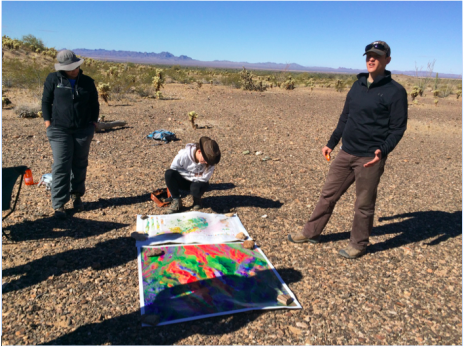
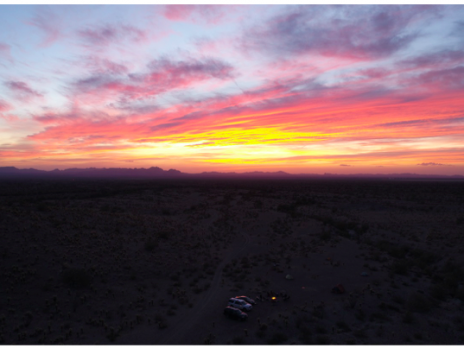
Ty Robinson writes: Accordion Closed
“Working with some very talented undergraduates in our department, we’ve submitted two HURA proposals and one Space Grant proposal (so far!). The topics of these proposals include studying transit and secondary eclipse observations of Earths orbiting M dwarf hosts, and understanding how well mission concepts like WFIRST/rendezvous, HabEx, and LUVOIR will perform when attempting to detect key life and habitability signatures from exoplanet atmospheres.”
Ty Robinson had a paper accepted Accordion Closed
with David Crisp (JPL): “Linearized Flux Evolution (LiFE): A Technique for Rapidly Adapting Fluxes from Full-Physics Radiative Transfer Models” in the Journal of Quantitative Spectroscopy and Radiative Transfer (JQSRT). Ty notes that while “the theory-heavy paper is a dense (dull?) read, there are two key points. First, we describe a technique that transforms a high-resolution radiative transfer model into a climate model, and several research teams across the country are already using this tool. Second, as a validation of our approach, we reproduce (for the first time ever, I believe) Venus’ thermal structure without a need for fudge factors or made-up opacities. So, our team is the only group that has the tools to understand the fundamentals of Venus’ greenhouse effect.”
Jean-Francois Smekens has a new paper, Accordion Closed
with M. Gouhier, in press in the journal of volcanology and geothermal research entitled “Observation of SO2 degassing at Stromboli Volcano using a Hyperspectral thermal Infrared Imager“.
Annika Gustafsson was a finalist for the student member of ABOR Accordion Closed
(the student regent position). to get that far Annika went through a series of interviews on campus (up to and including with the president), and then had an interview with the governor two weeks ago. It’s too bad Annika wasn’t selected; she would have done a terrific job.
Alumnus Keith Wood visited the department. Accordion Closed
He graduated from our department in 2008 with his masters and is now a professor in the physics department at University of Connecticut.
We had at least 13 people attend the annual Lunar and Planetary Science Conference in Houston: Accordion Closed
Faculty Nadine Barlow, Mark Salvatore, and Christopher Edwards; postdocs Kristen Bennett and Maggie McAdam; grad students Lori Glaspie, Alissa Roegge, Nathan Smith, Aaron Weintraub, and Michael Zeilnhofer; and incoming PhD students Schuyler Borges, Sarah Lamm, and Will Oldroyd. Together this group (and others from NAU) were first authors or co-authors on around 40 presentations. [My apologies if I missed anybody on this!] Christopher reports from the conference that “every single person I talked to at LPSC was like ‘NAU fantastic!’ Including people I was not expecting to be paying attention. Everyone is paying attention.”
NAU has produced and distributed a new research package Accordion Closed
— very slick and great looking — that is being sent to other universities (and whoever else). Trilling, Edwards, and Trujillo are featured, and our Astronomy and Planetary Science program is one of ~10 that are presented in this new brochure.
Six of the Gibbs Lab group members will travel to the MRS Spring Meeting in Phoenix April 01 – 04. Accordion Closed
Dylan Nicholls, Etude O’Neel-Judy, and John Gibbs will give oral presentations, and Raaman Nair will give a poster presentation at the Symposium NM02—Active Colloids with Order.
Richard Gaughn takes 2nd place at 3MRP Accordion Closed
There were eight finalists for the grad college’s 3MRP (3 Minute Research Presentation) competition, and three are from our department: Sam Sankar, Richard Gaughn, and Trevor Cotter. Richard took second place — $2000 prize and entry into the southwest showdown (Arizona and Nevada schools). The story is here.
Andrew McNeill, David Trilling, and Michael Mommert have a new paper Accordion Closed
in press on the “Constraints on the Density and Internal Strength of 1I/’Oumuamua”
The interim report for the “Habitable Zone Explorer” (HabEx) concept mission has been submitted to NASA HQ. Accordion Closed
Ty Robinson co-led the exoplanet characterization portions of this report, and the concept will be considered for funding prioritization in the 2020 Decadal Survey of Astronomy and Astrophysics.
Ty Robinson and a great phys/astro undergrad Accordion Closed
submitted a Space Grant application.
The Virtual Planetary Laboratory project, which was proposed to the NASA Astrobiology Institute was selected for funding. Accordion Closed
Ty Robinson is the team lead on this multi-million dollar grant (led out of the University of Washington) includes five years of graduate student funding here at NAU. [Note from Trilling: A NASA press release and related NAU press activity will be coming soon — probably in the next week or two.]
Ty Robinson was also Co-I on a recently funded NASA Exobiology Proposal Accordion Closed
This project involves researchers at NASA Ames, Washington University, and NAU. The research focus for this work will be understanding the Earth’s atmosphere shortly after the giant impact that led to the formation of our Moon. We know that life originated very early in Earth’s history, and may have been influenced by the Moon forming impact.
February 2018
Former Masters student Kristen Milligan, Accordion Closed
who graduated in 2013, visited the department last week to say hi. She is working at Raytheon in Tucson. Kristen did her masters research under Chris Mann.
Postdoc Kristen Bennett has accepted a permanent job at the USGS Astrogeology Science Center here in Flagstaff. Accordion Closed
She will start in summer or perhaps early fall. Congratulations!
Jennifer Hanley, Accordion Closed
who is a postdoc at Lowell but who has her second home at NAU in the ice lab, has accepted a staff scientist (what they call tenure track) position at Lowell Observatory. I think this means many more years of continued collaboration, including in ice lab projects. Congratulations!
Women in Planetary Science and Exploration meeting in Toronto Accordion Closed
NAU had the largest non-Canadian contingent at the recent Women in Planetary Science and Exploration meeting in Toronto: Alissa Roegge, Maggie McAdam, Kristen Bennett, and Annika Gustafsson presented at the conference.
Funding Proposals Accordion Closed
In the first eight weeks of 2018—that is, January and February—our department submitted 15 funding proposals for a total proposed amount of $8.3M, with seven different PIs. These submitted proposals include four NESSF proposals submitted by PhD students — congratulations to them and their mentors. This tally includes only proposals that went through Cayuse; there was at least one white paper (pre-proposal) that went in during this time as well, and possibly more.
Mark Salvatore gave a colloquium Accordion Closed
at NAU/SESES entitled “Unraveling the Martian Paleoenvironment through Orbital and In Situ Investigations”
Christopher Edwards is a co-author on a paper published last week in Nature Geoscience Accordion Closed
“Widespread distribution of OH/H2O on the lunar surface inferred from spectral data,” which has received a lot of media attention.
Edwards co-authored a paper related to hyper spectral thermal infrared imaging Accordion Closed
in the field entitled submitted to the AGU Journal of Earth and Space Science.
Edwards co-authored a paper related to Terraforming Mars Accordion Closed
that has been submitted.
Kristen Bennett submitted a paper related to the sands of Gale crater Accordion Closed
to the AGU Journal of Earth and Space Science: “THEMIS‐VIS Investigations of Sand at Gale Crater“.
Edwards and Salvatore co-authored a paper in Astrobiology Accordion Closed
that was accepted related to the formation of clays and salts on Mars that was accepted in Astrobiology: “A Complex Fluviolacustrine Environment on Early Mars and Its Astrobiological Potentials“.
Our admitted PhD students during their visit to Flagstaff in early February Accordion Closed
touring DCT and Meteor Crater.
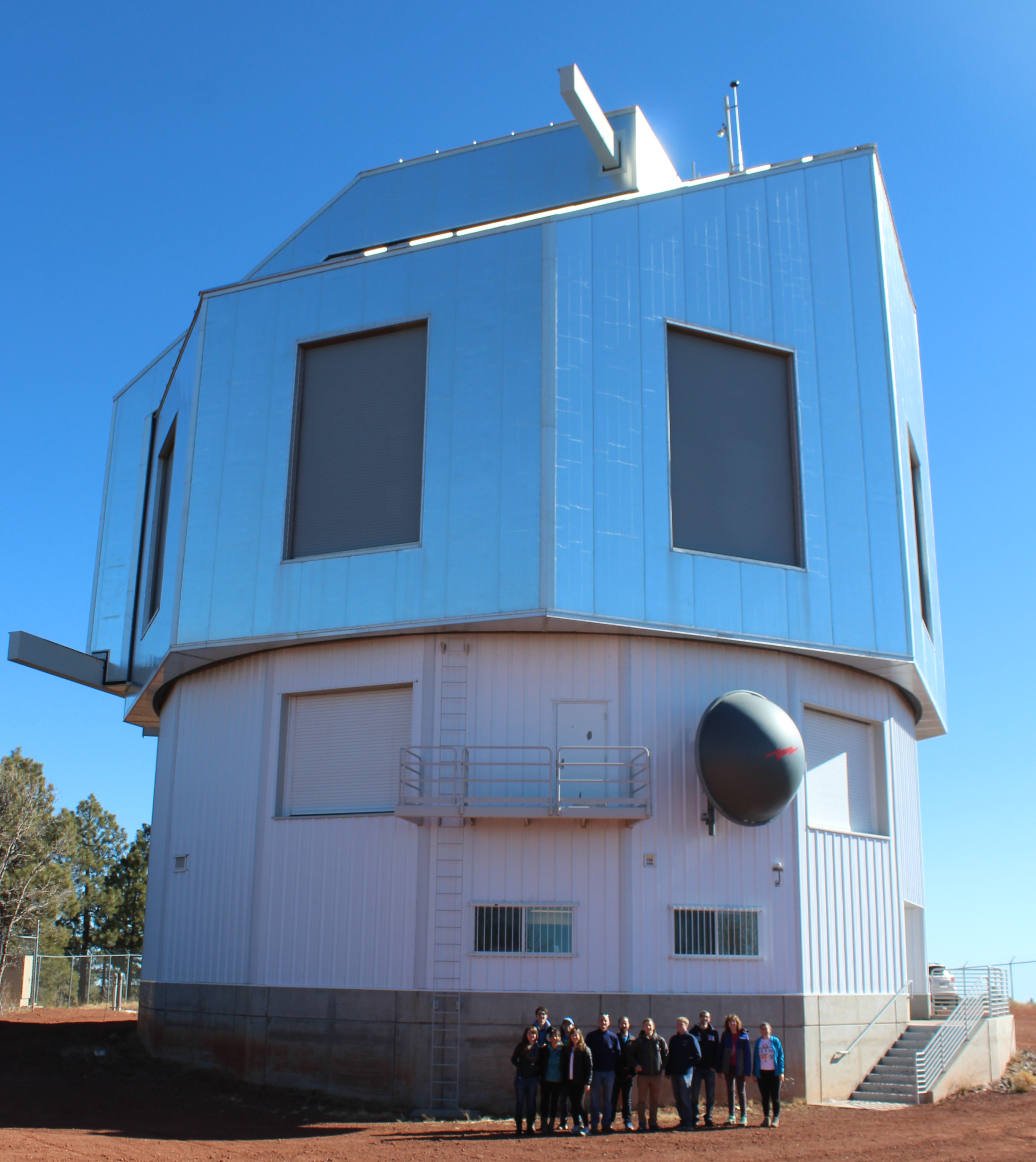
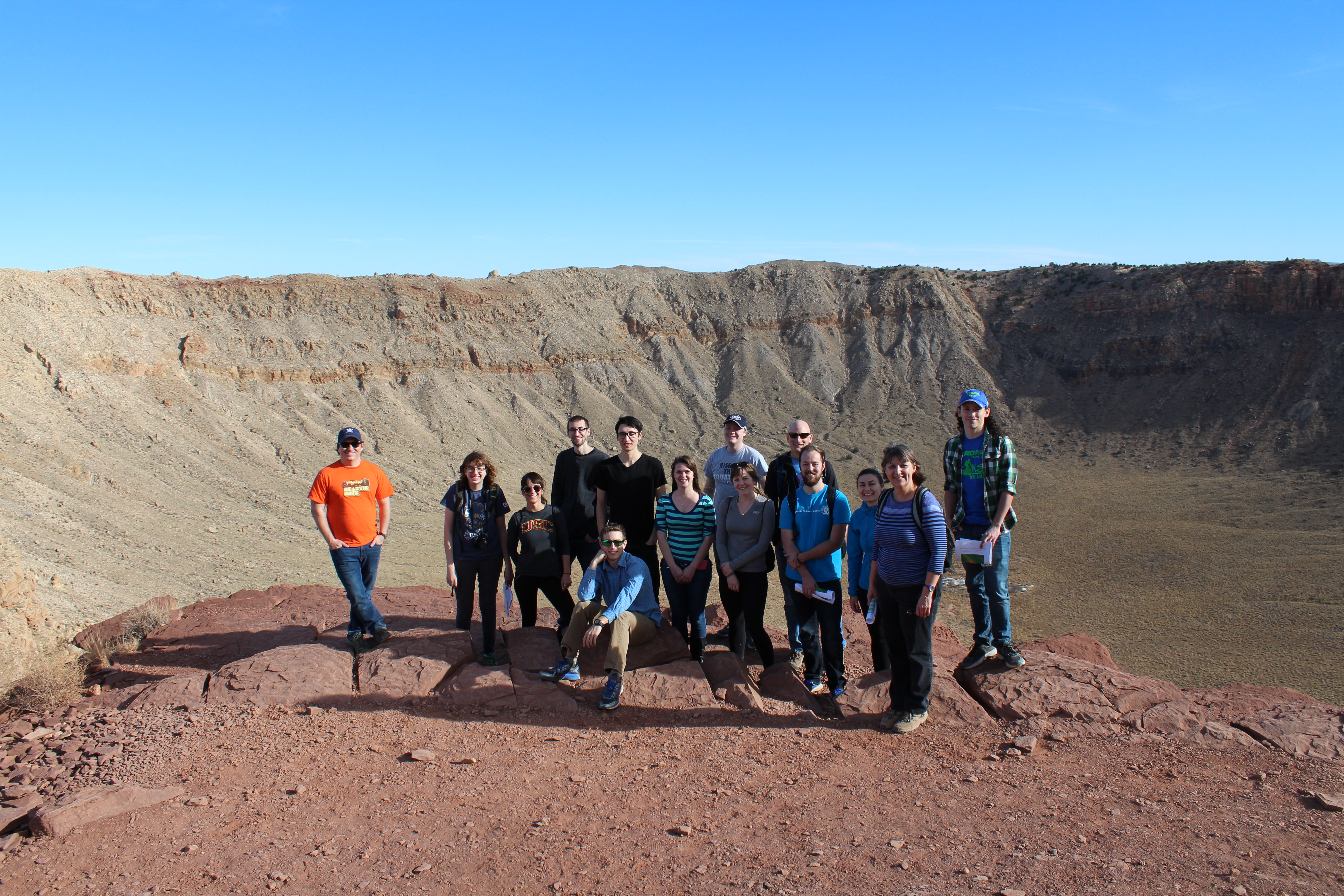
January 2018
Dave Schultz, Accordion Closed
Vice President for Research and faculty member in our department: “FYI, the new grant I got is from the NASA Astrophysics Research and Analysis (APRA) program. The rather ponderous title of the work is “Computational laboratory astrophysics to enable transport modeling of protons and hydrogen in stellar winds, the ISM, and other astrophysical environments.”
David Trilling’s research group on Oumuamua Accordion Closed
Trilling’s research mentioned in two articles:
-
-
-
- Scientific American: Oddball Object Tumbling among the Stars Could Disrupt Planetary Science
- National Geographic: Rock From Another Star System Has a Carbon-Rich Coating
-
-
Former student, JJ Zanazzi, Accordion Closed
submitted a paper, Effects of Disk Warping on the Inclination Evolution of Star-Disk-Binary Systems.
USGS researcher and sometimes REU mentor Colin Dundas Accordion Closed
is in the news with a big result:
Clara Berger (one of our REU students from 2017) Accordion Closed
presented at the recent AAS meeting. There were probably other REU and NAU alumni who presented as well, but I don’t have the details. Ty Robinson says he gave four (!) talks at the AAS meeting.
Nathan Smith was awarded an travel grant Accordion Closed
to attend and present at NASA’s SBAG (Small Bodies Assessment Group) meeting.
The Edwards Research group submitted 7 abstracts Accordion Closed
to the annual Lunar and Planetary Science Conference (LPSC) as lead author (Edwards, Bennett X2, Pan, Smith, Weintraub, Kozdon) and Edwards participated on another 8 LPSC abstracts as co-author. I’m sure there are lots of other NAU people on LPSC abstracts; we can hear more about that in March during/after the conference.
Christopher Edwards co-authored a white paper for the National Academies Committee on Astrobiology Accordion Closed
regarding the strategy of multiple landed mission for Mars exploration:
Mars as a Linchpin for the Understanding the Habitability of Terrestrial Planets: Discoveries of the Last Decade from Mars and Why a New Paradigm of Multiple, Landed Robotic Explorers is Required for Future Progress in Terrestrial Planet Astrobiology
Edwards was a co-author on a Nature Geoscience paper Accordion Closed
that was accepted for publication related to the OH/H2O content of lunar regolith: “Widespread distribution of OH/H2O on the lunar surface inferred from spectral data”
The ten astro/planetary faculty all are listed authors Accordion Closed
on an LPSC abstract that describes our new PhD program (Salvatore et al.).
Nadine Barlow wrote Accordion Closed
“For LPSC I submitted two abstracts as 1st author and 2nd year PhD student Michael Zeilnhofer submitted an abstract on the work that he is conducting with me for his PhD. I was a co-author on five additional abstracts, including the one that Mark Salvatore submitted about our new PhD program.”
Astronomy master’s student Nathan Smith Accordion Closed
presented research on Mars’ largest moon at NASA’s Small Bodies Assessment Group meeting on Jan. 25. He spoke on “A Thermophysical Model of Phobos,” explaining how the surface of Mars’ largest moon heats up and cools down over time.
First year PhD student Lauren Biddle has a paper in press, Accordion Closed
with co-authors, Lowell researchers Lisa Prato (Lauren’s advisor), Joe Llama, and Brian Skiff: “K2 reveals pulsed accretion driven by the 2 Myr old hot Jupiter CI Tau b.”
Christopher Edwards, Mark Salvatore, Nadine Barlow, Kristen Bennett, Accordion Closed
and a number of USGS folks are organizing a bunch of sessions and a field trip for the Geological Society of America regional meeting to be held in Flagstaff in May.
Undergraduate student Bradley Moldermaker and masters student Nathan Smith observed the lunar eclipse Accordion Closed
early on Wednesday morning with TIPSI, the thermal infrared camera on our campus telescope. The goal is to measure the thermal inertia of the moon.
This weekend [Feb. 3,4] we will have 12 admitted PhD students visiting Flagstaff. Accordion Closed
These students, plus a 13th who couldn’t make it this weekend, are being recruited for our third incoming class in our PhD program in astronomy and planetary science and would start in August, 2018. We’ll have them on campus Friday and spend all day Saturday on a field trip to the Discovery Channel Telescope and Meteor Crater.
Nadine Barlow participated in the STEM Day activities at STAR School in Leupp Accordion Closed
on Jan. 29. She and Vanessa Fitz-Kesler (CSTL) worked with 4th-6th grade students on an activity to select landing sites on Mars. She also helped provide information and answer questions for the Solar System Scale Model exercise on the school’s playground. Kathleen Stigmon and Mary Lara also participated with telescopes for daytime solar viewing and an evening star party.
Contact the Department of Astronomy & Planetary Science
Photo Scrapbook